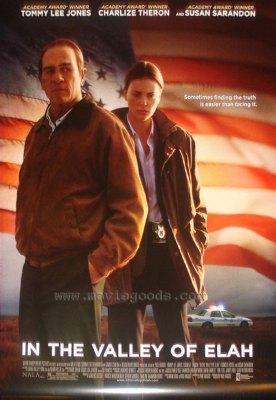| Reviews & Columns |
|
Reviews DVD TV on DVD Blu-ray 4K UHD International DVDs In Theaters Reviews by Studio Video Games Features Collector Series DVDs Easter Egg Database Interviews DVD Talk Radio Feature Articles Columns Anime Talk DVD Savant Horror DVDs The M.O.D. Squad Art House HD Talk Silent DVD
|
DVD Talk Forum |
|
|
| Resources |
|
DVD Price Search Customer Service #'s RCE Info Links |
|
Columns
|
|
|
In the Valley of Elah (HD DVD)
This dehumanization of American society in general and soldiers serving in Irag in particular - rather than the Iraq War itself - is at the heart of writer-director Paul Haggis' In the Valley of Elah (2007), a generally effective and intimate contemporary drama featuring an Oscar-nominated performance by Tommy Lee Jones.
Based on a true story, the film is structured as a mystery. Jones plays Hank Deerfield, a former MP investigator from the Vietnam era-turned-gravel hauler who receives a phone call that his son Mike, just back from a tour in Iraq, has gone AWOL. Leaving wife Joan (Susan Sarandon) behind, Hank jumps into his Ford pickup and drives from his home in Tennessee to New Mexico, to the (fictitious) Fort Rudd. Wanting to spare his son from getting into too much trouble he goes looking for his boy, even attempting to file a missing person's report with unhelpful local police Detective Emily Sanders (Charlize Theron, overly deglamorized).
(Mild Spoilers) Early in the film, Mike's body is discovered in the desert just outside of town, burned almost beyond recognition. Because he's also been decapitated and his hands dismembered, police and army investigators suspect Mike was murdered by a Mexican-American gang in a drug deal gone bad, possibly over heroin smuggled back from Iraq. None of this makes any sense to Hank, who can't believe his clean-cut boy would have been involved with such things.
One thing's for certain, the Army is anxious to sweep the entire incident under the rug, initially claiming the crime fell under their jurisdiction. After it becomes clear Mike was murdered not on Army-owned land but city property, they stonewall Detective Sanders' efforts to interview Mike's friends, among other things. Meanwhile Hank, having stolen Mike's cell phone from the base, hires a computer expert to unscramble its corrupted media files, which include disturbing video of Mike's tour in Iraq, and which may hold the key to his disappearance and murder.
Despite its awkward title, drawn from the story of David and Goliath, In the Valley of Elah is a compelling work that, in an impressively intimate and understated way - quite unlike Haggis' greatly overstated Crash - dramatizes how war dehumanizes people. In early scenes, former MP Sergeant Hank is like one of the boys. After all, he served in Vietnam; he was a career army man who still polishes his shoes and makes his bed like he's still a soldier. Yet the area around Fort Rudd is totally alien and unfamiliar, a desert community of gun shops, strip clubs, and crummy motels. People tend to be unhelpful when not downright unpleasant.
Though Haggis reportedly wanted Clint Eastwood (for whom he wrote the superb Million Dollar Baby) for the lead, Tommy Lee Jones (who starred with Eastwood in Space Cowboys) proved a much better choice. Jones has made something of a career specializing in emotionally-detached characters or ones whose emotions are buried way down deep, a trend dating at least as far back as his fascinatingly enigmatic title performance in The Amazing Howard Hughes (1976). His work here makes an interesting contrast to Jack Lemmon's atypically unsubtle acting in Missing (1982).
The film doesn't really say anything new or revelatory. The military's desire to assume control over and publicly bury the crimes of its servicemen is old news, dramatized in dozens of films before this. (Though undeniably still an issue. This very week the military has been condemned by the Japanese government for its handling of case involving a Marine accused of raping a 14-year-old girl off-base in Okinawa, one of a series of violent crimes by servicemen that the Japanese government isn't allowed to prosecute.)
Similarly, the thriller-like aspects of the crime, the apathy toward getting at the truth by the army and local law officials, etc., have been done to death. However, the film's approach is engagingly unusual, gradually unlocking its mysteries through Hank's methodical, internalized perspective. The despairing atmosphere, in which bombed-out Iraq and the American Southwest are unexpectedly blurred, is very effectively realized.
The film is most interesting in the ways - most subtle and intelligent, a few forced and obvious - in which Haggis shows us this dehumanization. There's a common thread in the film, very effective, likening the abuse/killing of animals, dogs in particular, to human beings. Early on, for instance, a woman complains to Detective Sanders that her soldier husband drowned their Doberman. If he's that casual about killing a dog, she asks, what about people? Haggis likewise weaves interesting connections between Hank, who now has outlived both his sons (an older boy, also a soldier, died in a helicopter accident), and single mom Emily and her son.
Much less effective is some hard-to-swallow, overly-symbolic business early on involving Hank correcting an immigrant from El Salvador (a high school janitor? the film is hazy about this) flying the American flag upside-down, oblivious to its symbolic signal of "dire distress." The film ends on a painfully false coda, with Hank predictably re-raising the inverted flag. (One wishes the put-upon janitor had complained, "Can't you make up yer mind?!")
Video & Audio
Filmed in Super 35, In the Valley of Elah looks great on HD DVD (Warners is also releasing a Blu-ray edition). Though the film's story would suggest a visual style comparable to an HBO original movie, cinematographer Roger Deakins (who also shot the similar No Country for Old Men, also starring Jones) gives the film an unobtrusive but very cinematic style, and the razor sharp, basically flawless 2.40:1 scope image has strong, atmospheric use of color. An HD DVD / DVD combo format disc (the latter is 16:9 enhanced and region 1 encoded) is full 1080p.
The audio isn't particular aggressive, though the Dolby TrueHD 5.1 and Dolby Digital Plus 5.1 tracks are impressive for what they are, making the most of Mark Isham's excellent score. 5.1 tracks in French and Spanish are also available, along with subtitles in all three languages on both the HD DVD and standard-def DVD.
Extra Features
Supplements, in standard 480i/p, are limited to two good featurettes and a good additional scene that probably should have been left in the final cut. After Iraq and Coming Home, running about 45 minutes in all, look at the film's production and its fidelity to the real-life murder case on which it's based, and the rampant post-traumatic stress disorder experienced by returning servicemen.
Parting Thoughts
Though its story and themes are a bit overly familiar, particularly in a year choking with several like-minded films, In the Valley of Elah touches on timely and universal issues of interest to every American, and at its center is an Oscar-worthy performance by Tommy Lee Jones. The HD DVD offers an excellent presentation and is Highly Recommended.
Film historian Stuart Galbraith IV's latest books, Japanese Cinema and The Toho Studios Story, are now available for pre-order.
|
| Popular Reviews |
| Sponsored Links |
|
|
| Sponsored Links |
|
|
| Release List | Reviews | Shop | Newsletter | Forum | DVD Giveaways | Blu-Ray | Advertise |
|
Copyright 2024 DVDTalk.com All Rights Reserved. Legal Info, Privacy Policy, Terms of Use,
Manage Preferences,
Your Privacy Choices | |||||||















